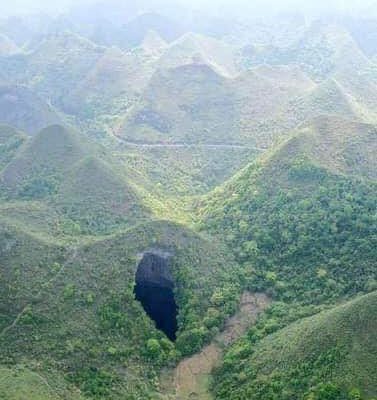Deep within a sinkhole in China’s Leye-Fengshan Global Geopark, 630 feet below the surface, a remarkable old forest has been discovered. This geopark is situated in China’s Guangxi Zhuang Autonomous Region and is recognized by UNESCO for its unique geological features.
The geopark is primarily sedimentary, composed of Devonian to Permian carbonate rocks, and it exhibits various karst formations, including caves, natural bridges, and extensive cave systems. It also hosts fascinating geological features like high karst peak clusters (fengcong), poljes, karst springs, karst windows (tiankengs), natural bridges, massive cave chambers, and speleothems.
In May 2022, scientists found a new sinkhole in the geopark, measuring over 1,000 feet in length, 490 feet in width, and nearly 630 feet in depth. Within this massive sinkhole, many old trees and plants were discovered, some of which might represent previously undocumented species.
The researchers found three cave openings within this colossal sinkhole, which provides a unique habitat for various plant and animal species. According to Chen Lixin, the leader of the expedition, they may encounter species in these caves that have yet to be documented by science.
Karst landscapes, characterized by sinkholes and caves, vary significantly depending on location, temperature, and other factors. In the southern part of China, where this geopark is located, the karst terrain is particularly impressive, with enormous sinkholes and expansive cave entrances. In contrast, karst formations in other parts of the world may have smaller, less conspicuous sinkholes and cave entrances.
The formation of sinkholes in karst landscapes is influenced by the dissolution of bedrock by slightly acidic rainwater. Rainwater, as it percolates through the ground, absorbs carbon dioxide, becoming more acidic. This acidic water then seeps through cracks in the bedrock, gradually carving out tunnels and cavities. When these underground spaces become sufficiently large, the overlying rock collapses, creating sinkholes.
This newly discovered sinkhole marks the 30th known opening in the area, showcasing the geological wonders of China’s karst landscapes. China is also home to Xiaozhai Tiankeng, the world’s largest sinkhole, measuring 2,100 feet deep, 2,000 feet long, and 1,760 feet wide, complete with a stream running through it, resembling a scene from the popular game Minecraft.
The discovery of this forest within the sinkhole highlights the hidden wonders of our planet and the importance of preserving these unique geological features.








